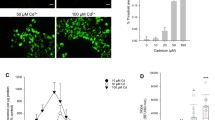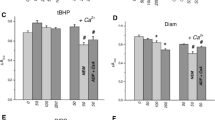Summary
The initial mechanisms of injury to the proximal tubule following exposure to nephrotoxic heavy metals are not well established. We studied the immediate effects of silver (Ag+) on K+ transport and respiration with extracellular K+ and O2 electrodes in suspensions of renal cortical tubules. Addition of silver nitrate (AgNO3) to tubules suspended in bicarbonate Ringer's solution caused a rapid, dose-dependent net K+ efflux (K m =10−4 m,V max=379 nmol K+/min/mg protein) which was not inhibited by furosemide, barium chloride, quinine, tetraethylammonium, or tolbutamide. An increase in the ouabain-sensitive oxygen consumption rate (QO2) (13.9±1.1 to 25.7±4.4 nmol O2/min/mg,P<0.001), was observed 19 sec after the K+ efflux induced by AgNO3 (10−4 m), suggesting a delayed increase in Na+ entry into the cell. Ouabain-insensitive QO2, nystatin-stimulated QO2, and CCCP-uncoupled QO2 were not significantly affected, indicating preserved function of the Na+, K+-ATPase and mitochondria. External addition of the thiol reagents dithiothreitol (1mm) and reduced glutathione (1mm) prevented and/or immediately reversed the effects on K+ transport and QO2. We conclude that Ag+ causes early changes in the permeability of the cell membrane to K+ and then to Na+ at concentrations that do not limit Na+, K+-ATPase activity or mitochondrial function. These alterations are likely the result of a reversible interaction of Ag+ with sulfhydryl groups of cell membrane proteins and may represent initial cytotoxic effects common to other sulfhydryl-reactive heavy metals on the proximal tubule.
Similar content being viewed by others
References
Balaban, R.S., Soltoff, S.P., Storey, J.M. Mandel, L.J. 1980. Improved renal cortical tubule suspension: Spectrophotometric study of O2 delivery.Am. J. Physiol. 238:F50-F59
Benos, D.J., Mandel, L.J., Simon, S.A. 1980. Effects of chemical group specific reagents on sodium entry and the amiloride binding site in frog skin: Evidence for separate sites.J. Membrane Biol. 56:149–158
Cass, A., Dalmark, M. 1973. Equilibrium dialysis of ions in nystatin-treated red cells.Nature New Biol. 244:47–49
Clarkson, T.W., Toole, S.R. 1964. Measurement of short-circuit current and ion transport across the ileum.Am. J. Physiol. 206:658–668
Cleland, W.W. 1964. Dithiothreitol, a new protective reagent for SH groups.Biochemistry 3:480–482
CRC Handbook of Chemistry and Physics. 1970. R.C. Weast, editor, p. B-232. The Chemical Rubber, Co., Cleveland, Ohio
Curran, P.F. 1972. Effect of silver ion on permeability properties of frog skin.Biochim. Biophys. Acta 288:90–97
Gerencer, G.A., Corvette, K.M., Loo, S.Y., Hong, S.K. 1977. Effect of silver chloride on the short-circuit current across the isolated toad skin.Life Sci. 20:1883–1890
Gerencer, G.A., Loo, S.L., Cornette, K.M. 1983. Effect of silver on sodium transport across toad skin.Comp. Biochem. Physiol. 75C:337–341
Gillis, K., Gee, W., Falke, L., Misler, S. 1987. Opposite actions of two structurally similar sulfonamides on an ATP sensitive K+ channel in adult pancreatic B-cells and RINm5F insulinoma cells.Biophys. J. 51:53a
Gogelein, H., Greger, R. 1984. Single channel recordings from basolateral and apical membranes of renal proximal tubules.Pfluegers Arch. 401:424–426
Gould, G.W., Colyer, J., East, J.M., Lee, A.G. 1987. Silver ions trigger Ca2+ release by interaction with the (Ca2+−Mg2+)-ATPase in reconstituted systems.J. Biol. Chem. 262:7676–7679
Gritzka, T.L., Trump, B.F. 1968. Renal tubular lesions caused by mercuric chloride.Am. J. Pathol. 102:271–281
Gurd, F.R.N., Wilcox, P.E. 1956. Complex formation between metallic cations and proteins, peptides and amino acids.Adv. Protein Chem. 11:311–427
Harris, S.I., Balaban, R.S., Barrett, L., Mandel, L.J. 1981. Mitochondrial respiratory capacity and Na+- and K+-dependent adenosine triphosphatase-mediated ion transport in the intact renal cell.J. Biol. Chem. 256:10319–10328
Harris, S.I., Patton, L. Barrett, L., Mandel, L.J. 1982. (Na+,K+)-ATPase kinetics within the intact renal cell.J. Biol. Chem. 257:6996–7002
Humes, H.D., Weinberg, J.M. 1986. Toxic nephropathies.In: The Kidney. B.M. Brenner and F.C. Rector, Jr., editors. Vol. II pp 1491–1532. W.B. Saunders, Philadelphia, Pa.
Hunter, M., Lopes, A., Boulpaep, E., Giebisch, G. 1986. Regulation of single K+-channels from apical membrane of rabbit cortical collecting tubule.Am.J. Physiol 251:F725-F733
Kawahara, K., Hunter, M., Giebisch, G. 1987. Potassium channels inNecturus proximal tubule.Am. J. Physiol. 253:F488-F494
Klyce, S.D., Marshall, W.S. 1982. Effects of Ag+ on ion transport by the corneal epithelium of the rabbit.J. Membrane Biol. 66:133–144
Knauf, P.A., Rothstein, A. 1971. Chemical modification of membranes. I. Effects of sulfhydryl and amino reactive reagents on anion and cation permeability of the human red blood cell.J. Gen. Physiol. 58:190–210
LaTorraca, F. 1962. Anatomo-histo-pathological and histochemical findings in acute experimental poisoning by silver salts.Folio Med. (Napoli) 45:1065–1067
Lauf, P.K., Theg, B.E. 1980. A chloride-dependent K+ flux induced by N-ethylmaleimide in genetically low K+ sheep and goat erythrocytes.Biochem. Biophys. Res. Commun. 92:1422–1428
Li, J.H., Sousa, R.C. de 1977. Effects of Ag+ on frog skin: Interactions with oxytocin, amiloride and ouabain.Experientia 33:433–436
Lowry, O.H., Rosebrough, N.J. Farr, A.L., Randall, R.L. 1951. Protein measurement with the Folin phenol reagent.J. Biol. Chem. 193:265–275
Lucke, B. 1946. Lower nephron nephrosis, the renal lesions of crush syndrome of burns, transfusions and other conditions affecting the lower segment of the nephrons.Mil. Surg. 99:371–396
Misler, S. 1987. Tolbutamide inhibits an ATP sensitive K+ channel in cardiac myocytes.Biophys. J. 51:53a
Nechay, B.R., Saunders, J.P. 1984. Inhibition of adenosine triphosphatase in vitro by silver nitrate and silver sulfadiazine.J. Environ. Pathol. Toxicol. Oncol. 5:119–126
O'Grady, S.M., Palfrey, H.C., Field, M. 1987. Characteristics and functions of Na−K−Cl cotransport in epithelial tissue.Am. J. Physiol. 253:C177-C192
Passow, H., Rothstein, A., Clarkson, T.W. 1961. The general pharmacology of the heavy metals.Pharmacol. Rev. 13:185–224
Rangachari, P.K., Matthews, J. 1985. Effect of Ag+ on isolated bullfrog gastric mucosa.Am. J. Physiol. 248:G443-G449
Rosenman, K.D., Moss, A., Kon, S. 1979. Argyria: Clinical implications of exposure to silver nitrate and silver oxide.J. Occup. Med. 21:430–435
Rosenman, K.D., Seixas, N., Jacobs, I. 1987. Potential nephrotoxic effects of exposure to silver.Br. J. Ind. Med. 44:267–272
Soltoff, S.P., Mandel, L.J. 1986. Potassium transport in the rabbit renal proximal tubule: Effects of barium, ouabain, valinomycin, and other ionophores.J. Membrane Biol. 94:153–161
Spooner, P.M., Edelman, I.S. 1976. Stimulation of Na+ transport across the toad urinary bladder byp-choromercuribenzene sulfonate.Biochem. Biophys. Acta 455:272–276
Tempel, B.L., Papazian, D.M., Schwartz, T.L., Jan, Y.N., Yan, L.Y. 1987. Sequence of a probable potassium channel component encoded atShaker locus ofDrosophila.Science 237:770–775
Walser, M. 1970. Calcium transport in toad bladder: Permeability to calcium ions.Am. J. Physiol. 218:582–589
Weinberg, J.M., Harding, P.G., Humes, H.D. 1982. Mitochondrial bioenergetics during the initiation of mercuric chloride-induced renal injury.J. Biol. Chem. 257:60–67
Weinberg, J.M., Harding, P.G., Humes, H.D. 1983. Alterations in renal cortex cation homeostasis during mercuric chloride and gentamicin nephrotoxicity.Exp. Mol. Pathol. 39:43–60
Wiater, L.A., Dunham, P.B. 1983. Passive transport of K+ and Na+ in human red blood cells: Sulfhydryl binding agents and furosemide.Am. J. Physiol. 245:C348-C356
Author information
Authors and Affiliations
Rights and permissions
About this article
Cite this article
Kone, B.C., Kaleta, M. & Gullans, S.R. Silver ion (Ag+)-Induced increases in cell membrane K+ and Na+ permeability in the renal proximal tubule: Reversal by thiol reagents. J. Membrain Biol. 102, 11–19 (1988). https://doi.org/10.1007/BF01875349
Received:
Revised:
Issue Date:
DOI: https://doi.org/10.1007/BF01875349




